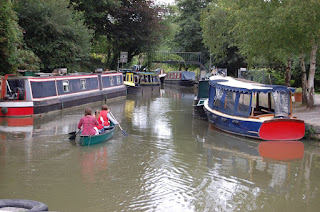Apologies for the very bad heading to this post, a play on the title of an album recorded by an English band back in the seventies. Can anyone guess the artist and year? However, it is meant to indicate what's been going on at Chateau Carney over the last few days.
As you will remember from my last post I've at last succumbed to the lure of the wonderful range of art materials available these days. The main thrust of this post then will be to talk a little about the experimenting I've been doing.
Instead of the swatches that I posted last week I thought I'd try to place the experiments in context and whilst not intending to produce a completed painting at least try to make the semblance of a picture. But before that let's look at some of the aspects I was trying to explore. One thing that's important in watercolour painting is the technique of placing paint and then softening an edge. Different pigments behave in a variety of ways when doing this. The first picture is a new pigment to me, Daniel Smith Amethyst Genuine. You can see that in this case the pigment has not migrated a long way and that is something for me to remember when using it again. It is an intriguing pigment, when viewed at an angle it appears to have particles that shine within it.
Amethyst Genuine by Daniel Smith
The next picture shows a section of a pigment called Moonglow by Daniel Smith. This one is in fact a mixture of two pigments, a blue and a red but what is interesting is the way the two pigments behave when in a wash. Effectively they separate and you can see both colours on the paper. This puts a new slant on the technique of mixing on the paper and ensuring that the colours retain their own individuality. In the picture you can see the pink/red colour migrating more quickly than the blue.
Moonglow by Daniel Smith
The next pigment on show here is another Daniel Smith creation, Sleeping Beauty Turquoise. This is a more straight forward pigment, nice and clean colour with a nice granulation settling in the depressions of the paper.
Sleeping Beauty Turqoise by Daniel Smith
The next picture taught me another lesson. I made a mix of Green Apatite and Indian Yellow to place some green on paper that was damp and what I found was that the Indian Yellow migrated out of the mixture and produced a yellow edge. I don't know why this surprised me having messed with chromatography techniques in a laboratory during working days. More work to be done where best to use mixtures and what effects to expect.
Indian Yellow goes walkies
The last picture is the source of all of the above extracts.
Flowers for Learning - Watercolour on Rough paper
I've been reviewing other bits and pieces in my painting kit and the brush has not escaped some attention. My favoured style of brush almost since starting to paint has been the sable brush. Recently noticing the numbers of artists using other types I decided to give some others a go. To be brief I started with some artificial and hybrid types and quickly rejected them as not holding as much pigment or releasing it as smoothly as my sables.
The next brush to try was the very popular Petit Gris used by many well known painters. I watched a couple of DVDs where they were the main brushes used by the artist and found this helpful in terms of the appropriate techniques to use. However, I found that even though I persevered it was not easy to shift between broad wash techniques and more delicate application. There was less control over the release of pigment than with the sables. They do encourage a loose technique and I won't consign them to the reject bin.
Once I'd confirmed my prejudices with regard to sables I decided to splash out and award myself a gift. I've had my eye on a Da Vinci Artissimo for some time and made up my mind that now was the time to dive in. A quick phone call to Jackson's and the die was cast.
Sable Selection - W and N size 8, Da Vinci Series 10 size 8, Da Vinci Artissimo size 2, SAA Kolinsky size 10, Da Vinci Series 10 size 12.
Head of Da Vinci Artissimo
I must confess to having fallen in love with this new brush. As you can see from the photograph the size of the head is similar to that of the Size 10. It holds a bucket of pigment and releases it as smoothly as you would like and it points magnificently. What's not to love?
Isabey Petit Gris size 6

















































